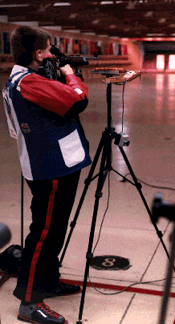![[ Subscribe ]](/art/subscribe.gif)

 On the Firing Line
On the Firing Line
This is one of the most intense moments of your life. Your pulse is racing, and sweat is running off your forehead and into your eyes, making you blink to relieve the stinging sensation. The last thing you need right now is any anxiety or any form of pressure as you practically lapse into a coma of total concentration. Your muscles are as relaxed as is humanly possible as your index finger touches the trigger...
The beginning of a suspense novel or action adventure, you may ask? No,
just a brief glimpse into the world of competitive smallbore rifle.
Throughout the world, millions of men and women actively compete
head to head in this sport which demands total mental and
physical concentration for hours at a time.
![[ Subscribe ]](/art/subscribe.gif)
"Rifle shooting?!? You mean that's really a sport?" I have heard that question countless times. Smallbore rifle competitions have been in existance since the early 1900's, and hold a rightful place in the summer Olympic Games. (In the 1992 Olympic Games, United States shooters Bob Foth and Launi Meili won silver and gold medals, respectively, in the three position events.) In this sport, men and women can compete shoulder to shoulder from an early age to well into their retirement years. The only time during which men and women do not compete side by side is during certain international competitions, such as the Olympics, since there are differing courses of fire. In addition, men and women with physical disabilites are actively competing, and are a common sight at rifle events. Not only is smallbore rifle appealing to a wide spectrum of people, but it also has a safety record which cannot be ignored - there have been no fatalities in the history of organized smallbore rifle competition. Football, boxing, and other high visibility sports cannot begin to approach this tribute to safety.
There are several types of smallbore rifle competitions, known in the shooting world as "matches", and are described by the position from which one fires. Prone matches are shot exclusively while laying horizontally on the stomach while supporting the rifle with the arms, shoulders, and a sling. Other categories of matches are called position matches, in which either three or four positions are all fired during the course. In a three position match, prone, standing, and kneeling are fired in that order, while four position matches include the sitting position.
The crux of a rifle match is simply to shoot the highest possible
score. The targets are located at a distance of 50 to 100 yards from
the firing line, depending upon the type of match.
Position matches are all fired at a distance of 50 meters (or on a target
reduced in size for firing at 50 yards for the minority of
the world who refuse to convert to the metric system). Prone matches
are fired at varying distance during the course of fire, beginning at
50 yards, and ending at 100 yards.

Competitive smallbore rifles are, by rule, single shot, bolt action, .22 caliber rifles, but are unlike anything one may expect to see at the local range. They often weigh in excess of 10 pounds, while the average hunting rifle is considered heavy if it weighs more than eight pounds. Their so-called "match" barrels are generally one inch in outside diameter, which helps resist overheating during a long match, while their rigidity and harmonics provide superior accuracy. The type of sights used on the rifle is dependant upon the type of competition that is entered. "International" matches are fired exclusively with open metallic peep sights, while conventional matches allow the use of metallic or telescopic sights. In conventional matches, one day of fire is dedicated exclusively to metallic sights, while a second day is labeled "any sights", allowing competitors to select their preference. The ammunition used for superior performance is subsonic, .22 rimfire, lead projectiles which travel around 900 to 1000 feet per second.
There is more to competitive shooting than just the equipment. The competition ultimately boils down to the individuals who hold the rifles. There is no innate natural ability in this sport (unless you include patience, dedication, and sacrifice), since no natural act remotely resembles the shooting disciplines. The competition is decided not by who is the fastest or the strongest, but by who can maintain the greatest levels of concentration and muscular coordination for an extended period of time.
![[ skew ]](/home.gif)